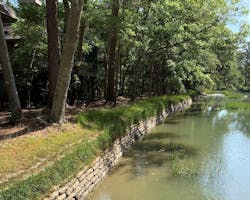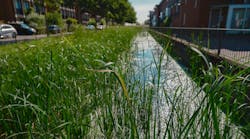Living Solutions
Eric Seidl, LEED-AP, is sales manager for Envirolok LLC. Seidl can be reached at [email protected] or 608.226.2573.
Located 25 miles southwest of Charleston, S.C., Kiawah Island, S.C., is one of the most popular barrier island destinations along the Atlantic Ocean. Living along the coastal waters presents many challenges for the residents of the island. While large-scale tropical storms and hurricanes, such as hurricanes Hugo and Matthew, certainly have played a role in erosive damage, tidal erosion is a constant battle along inlets, tidal canals and even the backwater ponds that intertwine the many golf courses on Kiawah Island.
Coastal Erosion
While rising sea levels may eventually play a larger role in erosion, the current challenges seem to be more related to a mixture of large storm events and tidal erosion that is escalated through high tides.
The island is defined by designated “critical zones” based on the amount of salinity in the water. In areas of high salinity surface water, permitting for shoreline improvements can only be obtained if the erosion is influenced by tidal conditions.
Outside of the critical zone, many of the pond edges experience erosion by a mixture of tidal influence, overland flow and frequent drawdown for irrigation. These ponds, along with the backwater wetlands, are important storm water features. The saltwater and freshwater mix in these ponds and canals, as well as fluctuating water levels, make it challenging to employ traditional erosion control and vegetative solutions.
The Kiawah Island Community Assn. (KICA) and its staff diligently work to protect critical habitat and real estate. The KICA maintenance department focuses on infrastructure projects, as well as land and lakes management. Through his work at the department, Ryan Ellmers, P.E., plays a vital role in engaging and empowering residents through a mix of committees, newsletters and social media that focus on conservation and restoration.
From brackish backwater wetlands to the Kiawah River corridor and ocean front dunes, each habitat is unique and has its own set of challenges. Through their collaboration with residents, KICA is driving the change for more sustainable approaches to tidal erosion in South Carolina. Instead of using traditional materials like concrete, stone and wood, private and public projects are embracing sustainable solutions.
With the goal of protecting tidal inlets, canals and ponds, KICA has developed standard practices that focus on sustainable, vegetative solutions that protect land, increase water quality and create natural habitat. While some projects may require integration of hard armoring solutions, the desired outcome is reinforced living shorelines. Without these standards, the erosion often is incorrectly fixed by homeowners or left until structures or infrastructure are in jeopardy of being damaged or lost.
A Permanent Solution
Because many of the waterways adjoin residential properties, site access can be challenging. KICA and the community residents collaborated with Envirolok on a variety of these projects. The Envirolok system creates a permanent vegetative solution that is fully engineered for specific site conditions. The geosynthetic bag system encapsulates the soil, protecting the banks from the erosive forces of soil, and provides ideal growing conditions for a variety of plants native to the tidal zones.
In Summer 2018, Envirolok met onsite with the KICA maintenance staff at one of the inlets just off the Kiawah River. Tidal erosion was a cause in the failure of the inlet banks. As water surged through the inlet during high tide and large storm events, the flow scoured the banks. Soil was eroding quickly enough that the banks of inlet coves crept beyond adjacent residential properties, putting land and infrastructure in danger.
Accessibility presented a problem. The tidal inlet only could be accessed by small equipment, and KICA wanted to minimize damage to the residential properties. Existing mature trees presented difficulties, as well. The solution required a limited construction footprint that would not impact the existing tree roots. The biggest challenge, however, was tidal conditions. While low tide provides ideal working conditions, water fluctuation can cause challenges for both construction in addition to establishing and growing vegetation.
The desired solution needed to be vegetative. No hard armoring would be permitted in the zone. The engineering team wanted to provide not only a solution for typical events, but also a permanent solution to withstand the potential for scouring from large, more infrequent storms.
The Storm Ahead
Creating permanent vegetative solutions takes careful thought and collaboration. Understanding nature, soils and water energy is critical. Selection of vegetation also is a critical piece of the success. Tidal zones are challenging; fluctuating water levels and salinity create a diverse and dynamic environment.
Although the average bank height and typical water flow would have allowed for a gravity system, the forces of mother nature can be a great challenge in the tidal zone. The force of large tropical storms needed to be considered in the design and construction.
In working with the KICA team, Envirolok engineered a solution that incorporated earth anchors to further reinforce the system and add shear strength. Because earth anchors can be driven into parent soil without the need for extensive excavation, the adjacent residential properties would remain almost untouched, and the contractor would be able to work around critical root zones of the existing trees.
To prevent future scouring, existing oyster “reefs” were left at the base of the canal. In addition to this living form of armoring, workers reinforced the toe of the slope with an additional embedment layer wrapped in geogrid 1 ft below the canal bottom. The design provided flexibility for slope setbacks between a 1H:1V to a 1H:2V, allowing the contractor to work within the range of slope in the existing banks.
High tide or unanticipated storms can wipe out site preparation and excavation in a hurry. A reduced construction footprint and installation simplicity were critical for this project. Working in low-tide conditions, Wade Steggall and his crew from S&S Coastal began site prep and excavation for the embedded footing. Bags then were installed, compacted and connected to the reinforced earth anchoring system using the Envirolok spikes.
Upon completion, the system then was ready for vegetation, using a mix of hydroseed applications and live plantings. Areas above the tidal zone included a specialized mix of native grasses applied directly to the bags using a hydroseed application with tackifier.
Plant species were carefully selected for the zone, as there tends to be less salinity above the tidal reach. Areas within the tidal zone instead were vegetated using live plant plugs, as they would be subjected to the fluctuating water levels and potential for washout. A mix of native plantings were added between the courses of bags. The teams ultimately coordinated with Mother Nature to provide a solution best suited for the island.


